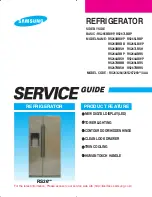
8
ENERGY SAVING TIPS
• Install the appliance in a dry, well ventilated
room far away from any heat source (e.g.
radiator, cooker, etc.) and in a place not
exposed directly to the sun. If required, use an
insulating plate.
• To guarantee adequate ventilation follow
installation instructions.
• Insufficient ventilation on the back of the
product increases energy consumption and
decreases cooling efficiency.
• The internal temperatures of the appliance are
affected by the ambient temperature, frequency
of door opening, as well as the location of the
appliance. These factors must be taken into
account when setting the thermostat.
• Allow warm food and drinks to cool down
before placing in the appliance.
• Do not obstruct the fan (if available) with food
items.
• After placing the food inside, check that the
compartment doors close properly, especially
the freezer door.
• Reduce door opening to a minimum.
• To thaw frozen food, place it in the refrigerator
compartment. The low temperature of the
frozen products will cool the food in the
refrigerator.
• Appliances could have special compartments
(fresh food compartment, zero degree box,
etc.). Unless otherwise specified in the specific
product booklet, they can be removed,
maintaining equivalent performance.
• Positioning of the shelves in the refrigerator has
no impact on efficient energy usage. Food
should be placed on the shelves in such a way
as to ensure proper air circulation (foods must
not touch each other and must not come into
contact with the inside rear wall).
• You can increase storage capacity of frozen food
by removing baskets and, if present, the Stop
Frost shelf, maintaining an equivalent energy
consumption.
• Damaged gaskets must be replaced as soon as
possible.
• High energy class products are fitted with high
efficiency motors that remain operational for
longer, but have a lower power consumption.
Do not be concerned if the motor continues to
run for longer periods.









































